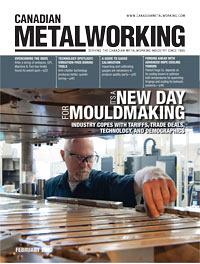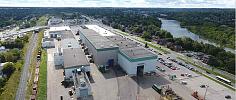Contributing Writer
- FMA
- The Fabricator
- FABTECH
- Canadian Metalworking
Forging ahead with advanced HDPE cooling towers at Patriot Forge
Patriot Forge Co. depends on its cooling towers to optimize bath temperatures for quenching forgings and cooling its hydraulic systems
- By Ed Sullivan
- February 25, 2019
- Article
- Management
The forging industry has achieved an impressive place in the North American industrial economy by producing components with unique benefits that are difficult to duplicate.
The process is known for producing parts that feature excellent fracture toughness and ductility, as well as both impact and fatigue strength.
However, delivering on those attributes also requires dealing with the high heat generated during forging, which can reach up to 2,100 degrees F. For Patriot Forge, Brantford and Paris, Ont., a supplier of custom open die and rolled ring forgings, controlling those high temperatures hinges on dependable cooling tower technology.
Frequently used for industrial applications such as refineries, metal foundries, and manufacturing plants, cooling towers remove heat from cooling system water and exhaust it into the atmosphere.
Needing an advanced system
Patriot Forge produces products in numerous materials, including carbon, alloy, stainless steel, nickel-based alloys, and aluminum. Producing for demanding industries such as power generation, petrochemical, heavy-equipment manufacturing, defence, and aerospace requires consistent quality, including the vital hardness characteristics of forgings ranging from 5 lbs. to 50 tons.
According to Derek Hynes, senior mechanical engineer at Patriot Forge, three years ago the company decided to begin the process of replacing its aging, multi-use cooling tower, located at Building One of its Brantford plant.
“The tower we were replacing was a traditional steel model that was rotting out,” Hynes explained. “Also, metal models tend to rust and corrode, which usually leads to plugging the water flow, and that can interfere with cooling capacity.”
The cooling tower is used to expel heat from the Building One quench system, a 42,000-gal. tank into which parts are submerged in water or polymer baths to achieve the desired hardness.
Hynes and his team took the time to investigate what other cooling tower design options were available that could provide reliable, trouble-free operation for a longer period of time.
The team ultimately chose a cooling tower constructed of high-density polyethylene (HDPE) manufactured by Delta Cooling Towers, the company that originally developed the engineered plastic technology.

Controlling the high temperatures of its forging process requires Patriot Forge to use cooling towers.
HDPE cooling towers are impervious to corrosive environments and require lower amounts of expensive water treatment chemicals as well as less downtime for repair or replacement, according to Delta’s experts. The tower manufacturer also offers models with energy-saving features such as direct-drive fan motors that can reduce electricity costs.
“We saw that this was a polymer-based tower that was UV-protected, and included a 20-year warranty, so we were convinced that it would offer long-term dependable service,” Hynes said.
Supporting multiple systems
After the initial HDPE tower was successfully installed, Patriot Forge decided to acquire a second HDPE cooling tower to support hydraulic cooling for its new 5,000-ton hydraulic press, rail-bound manipulator, and hydraulic ring roller.
“The [second] tower needed to support multiple systems within the Building One,” said Hynes. “This included cooling the water that flowed through a heat exchanger used to draw heat off the hydraulic systems of three large pieces of production equipment, including the 5,000-ton press that plays a primary role in the forging processes of the plant. Essentially, all three machines are cycling the water that flows through their hot hydraulic heat exchangers and then through this cooling tower. This enables us to keep the hydraulic fluids at a stable 110 degrees F.”
Extending the benefits
Patriot Forge then acquired an additional twin-cell HDPE cooling tower to help cool the quench tanks that are part of the company’s heat-treat system in Building Two.
“Both of the quench tanks are 105,000 gal., and we use the cooling towers to help maintain a heat level of approximately 100 degrees F,” Hynes said.
The cooling towers that Patriot Forge selected for this building were the same design as the one selected as a replacement in Building One, a Delta TM Series™ induced draft model.
One of the benefits of these towers is the ability to configure them in combination of up to six units with cooling capacity from 250 to 2,500 cooling tons. This modular design gives companies the opportunity to conveniently add cooling towers as their processing grows. The new cooling towers in Building Two are installed in a two-cell configuration with combined cooling capacity of 836 cooling tons.
“We decided on this size and configuration because the quench tanks in Building Two are much larger,” said Hynes. “So, there is a lot more water you have to process through the towers.”
He noted that installation was relatively easy.

Forging is known for producing parts that feature excellent fracture toughness and ductility, as well as both impact and fatigue strength.
“The HDPE plastic towers are lighter, so we were able to use a smaller crane to install them, which was much more convenient than having to deal with larger, bulkier cranes,” he said.
The towers also have vibration sensors on all fans, which eliminates the need to climb the towers to check the operating performance of the fans, a feature that Hynes feels is particularly appealing because one of the tower’s top reaches 65 ft. high.
Ed Sullivan is a Los Angeles-based freelance writer with over 30 years of expertise in the mechanical engineering, HVAC, and process cooling industries.
Delta Cooling Towers, www.deltacooling.com
Patriot Forge, www.patriotforge.com
About the Author
subscribe now


Keep up to date with the latest news, events, and technology for all things metal from our pair of monthly magazines written specifically for Canadian manufacturers!
Start Your Free Subscription- Industry Events
MME Saskatoon
- May 28, 2024
- Saskatoon, SK Canada
CME's Health & Safety Symposium for Manufacturers
- May 29, 2024
- Mississauga, ON Canada
DiPaolo Machine Tools Open House 2024
- June 4 - 5, 2024
- Mississauga, ON Canada
FABTECH Canada
- June 11 - 13, 2024
- Toronto, ON Canada
Zoller Open House & Technology Days 2024
- June 12 - 13, 2024
- Ann Arbor, MI





















